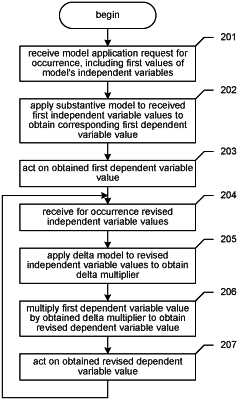| CPC G06N 20/00 (2019.01) [G06F 17/18 (2013.01); G06F 30/20 (2020.01); G06N 5/04 (2013.01)] | 12 Claims |

|
1. A non-transitory computer-readable medium having contents adapted to cause a computing system to:
receive a plurality of observations, each observation specifying values of each of a plurality of independent variables that include a distinguished independent variable designated to be monotonically linked to a dependent variable;
use the plurality of observations to construct a first machine learning model that-based on (1) a first set of values of the plurality of independent variables for which an estimated value of the dependent variable is to be provided, (2) a second set of values of the plurality of independent variables for which an estimated value of the dependent variable is to be provided, and (3) a value of the dependent variable estimated by a second machine learning model for the first set of values of the plurality of independent variables—estimates a multiplier by which the value of the dependent variable estimated by the second machine learning model for the first set of values of the plurality of independent variables is multiplied to obtain a value of the dependent variable for the second set of values of the plurality of independent variables,
wherein a value of the distinguished independent variable in the first set of values varies from the value of the distinguished independent variable in the second set of values in a first direction,
wherein a constraint specifies that the value of the dependent variable for the first set of values does not vary from the value of the dependent variable for the second set of values in a second direction that is opposite the first direction,
wherein the first machine learning model comprises a plurality of sub-models in declining complexity,
wherein a sub-model of the plurality of sub-models meets the constraint,
wherein a complexity of the sub-model is (a) less than a complexity of a preceding sub-model that does not meet the constraint and (b) greater than a complexity of a following sub-model that does meet the constraint,
wherein the sub-model is a function of one or more of the plurality of independent variables, and
wherein the complexity of the sub-model is based on at least a number of the one or more of the plurality of independent variables, a number of constrained spline functions in the function, or a number of unconstrained spline functions in the function.
|